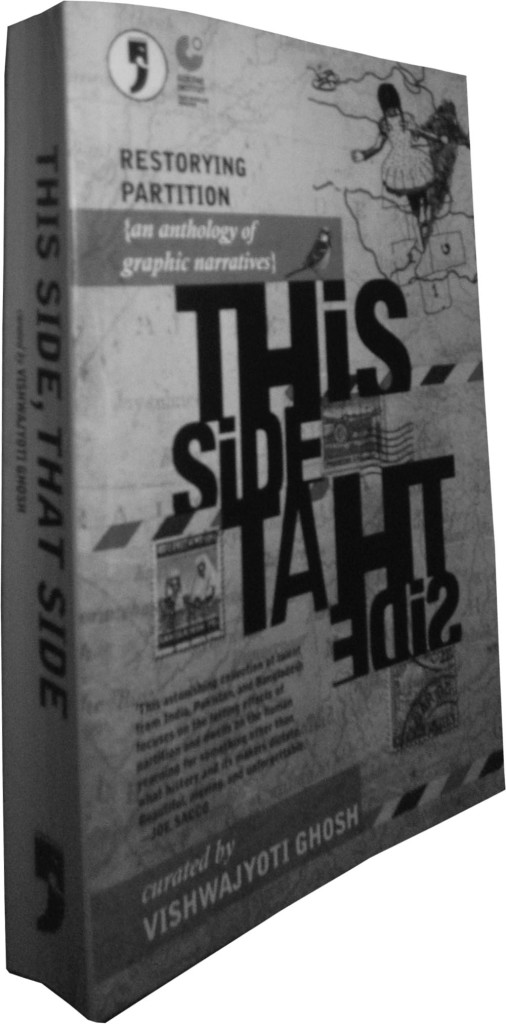by Ben Verghese.

Curated by Vishwajyoti Ghosh
Yoda Press and Goethe Institut Delhi, 2013
Many of the dominant narratives of the partition focus on events in 1947 – easy-to-caricature leaders, the two-nation theory and the birth of Pakistan. How then do we find ways to duly speak of one land mass being forcibly carved up; of the multiple peoples displaced; of the umpteen lives lost, and uncountable, unnameable numbers affected? And with so much already said, how do we speak of all this with new impetus?
The “restorying” in This Side, That Side avoids getting stuck in a single year or looking only (north)west. As the title implies, we experience viewpoints that battle, cross or straddle borders; perspectives of individuals and families stuck, gazing across demarcations, wondering what has come into being, what was and what could have been. Personal narratives are presented as multi-page postcards, vignettes that echo the repetition of histories.
At a glance, This Side, That Side’s myriad viewpoints might appear to add to the deluge of opinions on Partition (capital P) that continue to be created or collected, but its striking comic/graphic formats challenge how these views are presented, and how we read them with and against each other. Movement of peoples in and between India, Pakistan and Bangladesh are shown in works translated from Bengali, Hindi and Urdu, or written directly in English, Voices comment on and from Cooper’s Camp, no-man’s-lands, waterways. In their brevity, most of the stories also serve as ellipses. This Side, That Side travels backwards and forwards, suggesting that as long as there is life, events remain unfinished.
Encountering Partition through micro-narratives alone is no new thing. The brilliant satirical short story “Toba Tek Singh” by Sadat Hasan Manto, published in 1955, remains one of the sharpest depictions of India and Pakistan’s division. In contrast, through a decade of interviews and readings of personal documents Urvashi Butalia’s The Other Side of Silence: Voices from the Partition of India (Duke University Press, 2000) has attempted to show that so-called subalterns can speak clearly.
Opposing tones in Butalia’s and Manto’s texts provide undercurrents to This Side, That Side, although this new book also connects with “Lines of Control”, an ongoing exhibition-led research project by Green Cardamom (conceived in 2005), which examines visual artists’ engagement with Partition. These graphic stories add to a multitude of other examples in non-bound artworks, including Zarina Hashmi’s prints and “From 1.7 million mi² To 55,598 mi²” by Tayeba Begum Lipi.
Paper boat motifs in four This Side, That Side stories also bring to mind Tatha Rathore’s gouache-on-wasli series, “My Heart Too Will Find Its Shore”. In all, here are artists facing up to and battling with shared, brutal histories and the consequences of colonialism. And many are doing so beautifully.
Although the written words have been typed, overall hand-crafted textures are favoured and this sensitivity leaves its own mark. Lines drawn differently, fitting. Repeatedly maps are used as visual underlays to the action. “Border”, the third story in the collection, exemplifies this and takes us to street scenes, daydreams and bedroom cravings. Using pages as a canvas, New Delhi-based artist Hemant Puri allows the images to bleed into one another, guiding the eye and aiding narrative flow while echoing the subject matter. Extra commentary questioning the construct of nation-states is provided and speaks louder when drawn: a flag (hung at full mast) carries a design that shows a row of bare bottoms defecating into a communal pit latrine.
Gayatri Chakravorty Spivak’s voice echoes throughout: “Nationalism is the product of a collective imagination constructed through rememoration. It is the comparativist imagination that undoes that possessive spell.”
Top and tailing This Side, That Side are figurative takes on the very act under examination: a cut. First, Tabish Khair’s and Priya Kuriyan’s “An Old Fable” presents a pompous monocle-wearing British king bringing reason and law to the natives. When faced with a dispute between two women, one in a hijab and salwar kameez, the other with a sari and long hair on show, the king decides the best solution is to chop the problem (a newborn baby) in three pieces. Witty, but with thinly veiled metaphors when compared to the closing tale.
For the book’s final pages, the excellent artist and designer Orijit Sen reimagines a childhood game. “Making Faces: Nationality, Religion, Ethnicity, Gender, Race and other Indisciplines in South Asia” consists of eight portraits, each divided into three parts. Lower, middle and upper sections of each face are physically sliced from spine to the edge of the page and aligned so each section can be overlaid and played with as part of the portraits printed on the same side of the paper. A turban replaces a baseball cap, women appear as men and so on. Demographics jumbled, Sen’s work allows us to see how incidental appearance, and difference, can be, as well as assemble these differences. How ludicrous to form prejudices based upon looks. How fickle we can be. How confused we get. Furthermore, whether cut by machine or by hand, we face déjà vu. One joined space is incised three ways.
 This story features in the new edition of Chronic Books, the supplement to the Chronic. Through dispatches, features, interviews and reviews, we explore the reach of public relations and petrodollars.
This story features in the new edition of Chronic Books, the supplement to the Chronic. Through dispatches, features, interviews and reviews, we explore the reach of public relations and petrodollars.
To purchase in print or as a PDF head to our online shop. Copies coming to your nearest dealer now-now. Access to the whole issue and Chronic online archives is available for $28 for one year or $7 for a month.
[button link=”http://www.chimurenga.co.za/chimurenga-shop” color=”red”]Buy the Chronic[/button] [button link=”https://chimurengachronic.co.za/online-subscription” color=”black”]Subscribe to the Chronic[/button]
